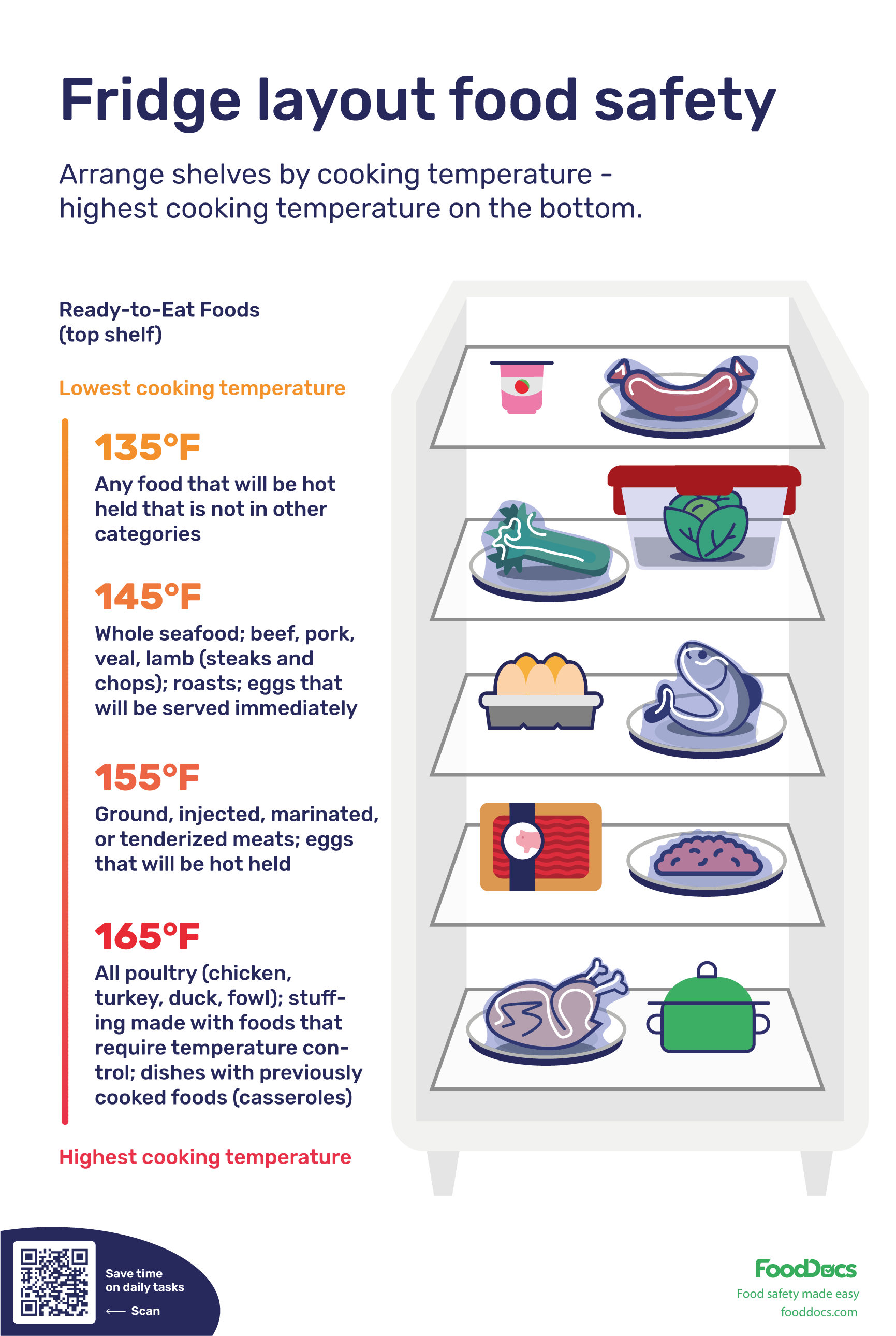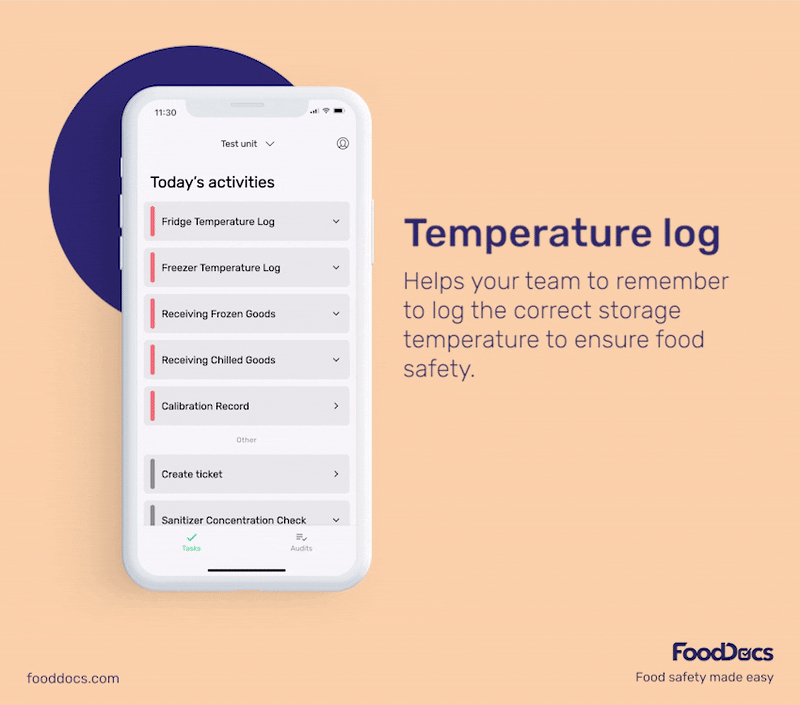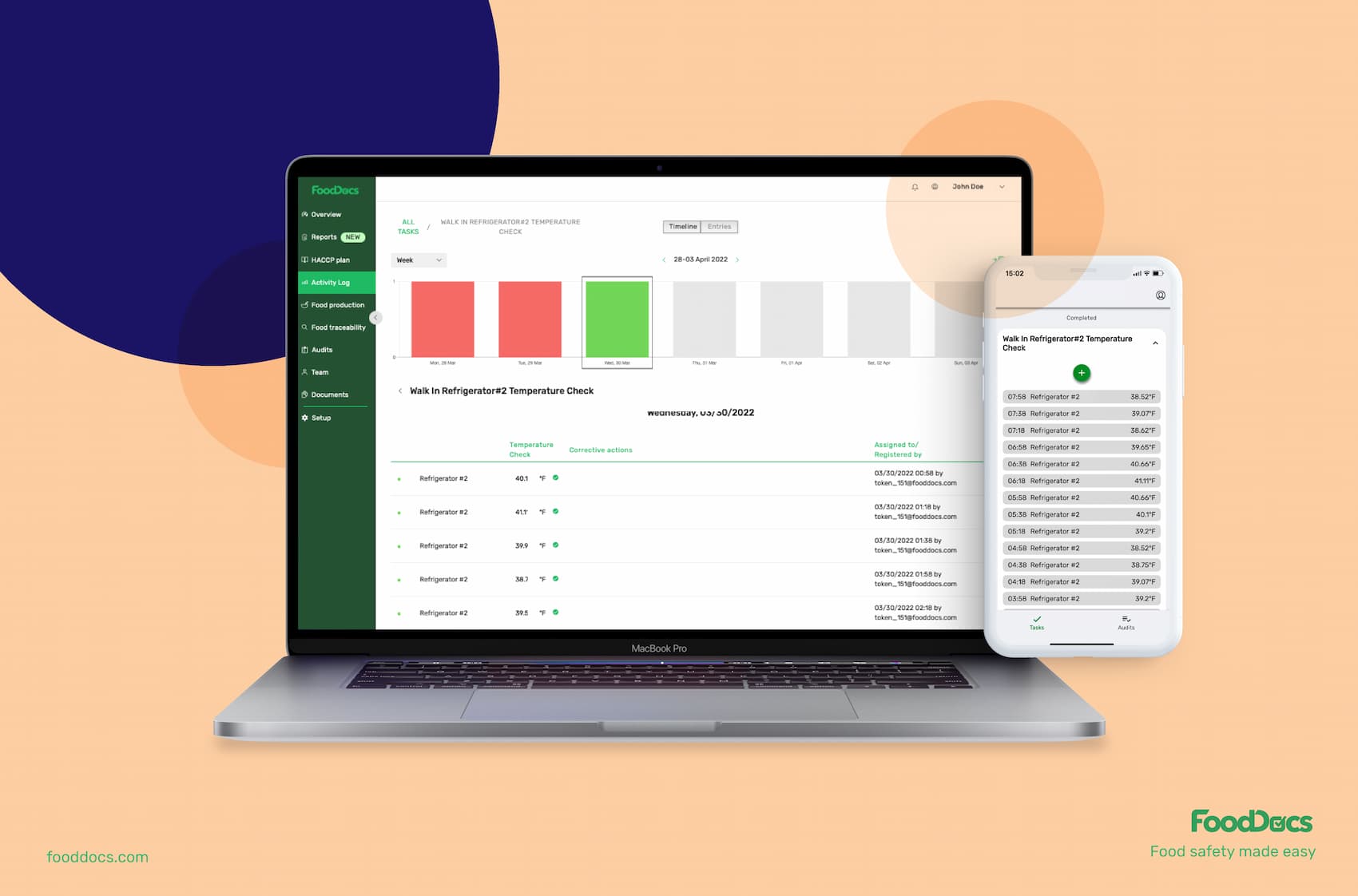Why Is Food Safety Important In Healthcare? Healthcare Leaders Guide
Learn challenges healthcare foodservice teams face today and key food safety practices to protect vulnerable patients. Get a free healthcare leader...


Thank you for downloading Food Safety Temperatures Chart!
Want to get a customizable HACCP template?
Or set up your food safety system in 15 minutes?
Tips for checking food safety temperatures include calibrating thermometers properly, regularly calibrating them, and always using the same steps to log temps.
But before jumping into those things, let's cover the why of it all.
Temperature controls are important because they help food safely pass through or keep food out of the danger zone altogether, which is the zone in which can pathogens quickly multiply and spoil foods in just a couple of hours.
Sources globally recognize that the temperature danger zone for food is between 40°F to 140°F (4°C to 60°C).
The general rule for keeping food out of the temperature danger zone is to never leave it out of the refrigerator for more than two hours. Furthermore, food safety agencies advise not to keep foods out of refrigeration or hot holding for more than one hour if the temperature is around 90°F (32°C).
There are also certain foods that the food industry categorizes as TCS, which stands for Time/Temperature Control for Safety.
TCS foods are named as such for one of the following reasons:
Some examples of foods that fit these descriptors are cooked, partially cooked, or raw meat, poultry, eggs or milk; raw plant-based foods such as sprouts, cut fruit, chopped leafy greens, diced tomatoes; plant-based foods like potatoes or rice; and mixtures like garlic in oil.
Understanding the way that TCS high-risk foods behave compared to less risky ones will significantly help food handlers formulate, prepare, and serve their food products to consumers in the safest way possible.
Characteristics of Time/Temperature Control for Safety foods include:
With a better background on the importance of maintaining food safety temperatures, let's jump into the specifics.

Kitchen staff, listen up — there are a few things you should always keep in mind when monitoring food temperatures.
In order to consistently get accurate readings on food temperatures, you must properly calibrate your kitchen thermometers. The calibration method may vary depending on the intended use of a food thermometer.
Depending on your intended use of a food thermometer, there are two main calibration methods:
We recommend using different thermometers for each of those purposes because using a single one for a wide range of temperature readings can more quickly lead to inaccurate readings.
Thermometer calibration should be a regular task for your food facility. In addition to doing daily calibrations, there are specific events that require additional calibrations including when a thermometer is:
Thermometers require a lot of care to maintain their accuracy. But they also require consistent use on behalf of food handlers. If you want to properly measure the internal temperature of foods, follow these steps:
Now it's time to apply those actionable steps.
Cooking food to the correct internal temperature ensures safety by eliminating harmful pathogens. Different foods require different internal temperatures for safe consumption:
Beef and bamb: For medium to medium-well doneness, beef and lamb should be cooked to at least 160°F (71°C), which eliminates E. coli. Some prefer beef cooked to 140°F (60°C) for medium-rare, while the USDA recommends 145°F (63°C) with a 3-minute rest time.
Pork: Safe cooking temperature is 145°F (63°C) with a 3-minute rest. Pork may carry instances of Salmonella, Listeria, and other pathogens.
Poultry: Chicken, turkey, and other poultry must reach 165°F (74°C) internally to avoid Salmonella and Campylobacter contamination. This is critical, as poultry is frequently linked to foodborne illnesses.
Egg products and egg dishes: Cook to 160°F (71°C) to prevent foodborne illness.
Fish: Cook to 145°F (63°C) for safety and to maintain texture without overcooking. Fish is associated with Norovirus and Vibrio.
Leftovers and casseroles: Reheat to 165°F (74°C), stirring to ensure even heating. Avoid re-refrigerating reheated food.
Ground meat: Ground beef, pork, and veal should be cooked to 160°F (71°C), while ground poultry must reach 165°F (74°C) due to the increased surface area and risk of contamination.



Thank you for downloading Food product specification sheet!
Want to get a customizable HACCP template?
Or set up your food safety system in 15 minutes?
These are the most widely recognized time-temperature combinations for cooking food that kills foodborne bacteria and reduces risks such as food poisoning:
Cooking food at the right temperature and for the correct length of time will ensure that any harmful bacteria are killed.
When it comes to hot holding temperatures, you must remember: food must be cooked to sufficient internal temperatures first. Once that's achieved, you can safely hold hot foods.
For food that is made:
While hot holding food preserves food by keeping it at temperatures of at least 135°F (57°C), cold holding refers to storing foods at low temperatures, around 41°F (5°C) and below. These cold food temperatures help ensure the timely use of supplies and prevent unnecessary spoilage that foodborne pathogens cause.
It's important to note that, depending on the food you serve and its composition, cold-holding temperatures may vary. For example:
Salad bar: Should be maintained at 41°F (5°C) or below to keep vegetables and fruits safe. Food in salad bars increase contamination risks due to customer exposure.
Tuna salad: Must be stored at 41°F (5°C) or below. Ingredients like mayonnaise and vegetables spoil easily, so refrigeration or ice is necessary.
Green salad: Should be kept at a maximum of 41°F (5°C). Refrigeration or ice prevents bacterial growth, and separating dressing from greens until serving helps maintain freshness.
Shredded lettuce: Must be cold-held at 41°F (5°C) to prevent food spoilage. Avoid cross-contamination by storing away from raw ingredients.
Salsa: Should be cold-held at 41°F (5°C) or below due to its high moisture content, which makes it prone to contamination.
Deli meat: Must be held at 41°F (5°C) or below and consumed within 3-5 days. Deli meats should be stored with similar products to prevent contamination.
Cheese tray: Cheese should be cold-held at 41°F (5°C). Soft cheeses like brie and camembert spoil faster due to higher water content and require more frequent temperature monitoring.
Egg salad sandwiches: Cold-holding should not exceed 41°F (5°C). Egg salad is high-risk, containing eggs and mayonnaise, and should be consumed within 3-5 days.
Watermelon: Sliced watermelon must be kept at 41°F (5°C) or below. Refrigeration after slicing is essential to minimize contamination risks.
Yogurt: Cold-holding temperature is 41°F (5°C) or below. Yogurt must be stored on the top shelf of the refrigerator to avoid cross-contamination.

As you can see, 41°F (5°C) is the most common cold-holding standard for food safety. A couple of exceptions include foods such as:
Download our free cold food storage rules poster.
In order to slow the bacteria growth rate in foods such as meat, dairy products and cooked leftovers, the FDA recommends keeping your refrigerator temperature at or below 40°F (4°C).
"Below" is quite general and can also result in fridge food freezing, which isn't ideal. (Otherwise you'd put it in the freezer, right?)
That's why, as shown in our fridge temperature chart, an ideal temperature range for your refrigerators is 32-40°F (0-4°C).
The ideal range for a freezer temperature is 0°F (-18°C) or lower. Compared to warmer temperatures, freezing food at or below this temperature will stop the growth of microorganisms, which makes it a great option for proper food storage for the long-term.
A few other benefits of freezing food safely include:
Extending shelf life of perishable food
Minimizing food waste by preserving surplus
Keeping food safe for long-term storage while maintaining quality
Our guide to freezing food has even more tips for freezing food, steps involved in shipping frozen food, and more!
Thousands of people use our free food safety templates, and many of them go on to try FoodDocs' digital Food Safety Management System to streamline tasks like food safety checks, verification, and more.
FoodDocs quickly transforms traditional paper-based systems into digital solutions, making it easier for teams to stay compliant with food safety standards, from monitoring to traceability.
Whether you’re tracking temperatures for hot holding, cold holding, refrigerators, or freezers, FoodDocs has you covered.
You can use our software’s automatically generated logs or design custom temperature logs tailored to your specific operations.

With the mobile app downloaded, you'll:

Start your 14-day free trial and start logging food safety temperatures!
Digital logs improve accuracy in two key ways:
If you oversee your company’s food safety compliance, the real-time dashboard is an invaluable tool. It offers a high-level view of which locations or departments are fully or partially compliant.

Whether you’re on-site or working remotely, you can set up food safety tasks that require verification once team members complete their entries. This feature is crucial for businesses dedicated to maintaining top-tier food safety standards.
A food handler should the temperature of food by inserting the thermometer probe into the thickest part of the food, at least half an inch deep, for solid foods. For liquid foods, dip the thermometer probe at least 1/4 above the bottom of the container.
You'll find links to food-specific temperature charts below! But we've included the most common temperature to give you an idea of what internal temperatures you should hit when cooking the following foods.
What temperature do you cook:
Learn challenges healthcare foodservice teams face today and key food safety practices to protect vulnerable patients. Get a free healthcare leader...
Learn what Standard Operating Procedures (SOPs) are and how to write effective SOPs that ensure consistency, efficiency, and safety in your...
Boost your retail food safety with essential practices and digital tools to protect customers and your brand. Plus a free Retail Food Safety Leader...